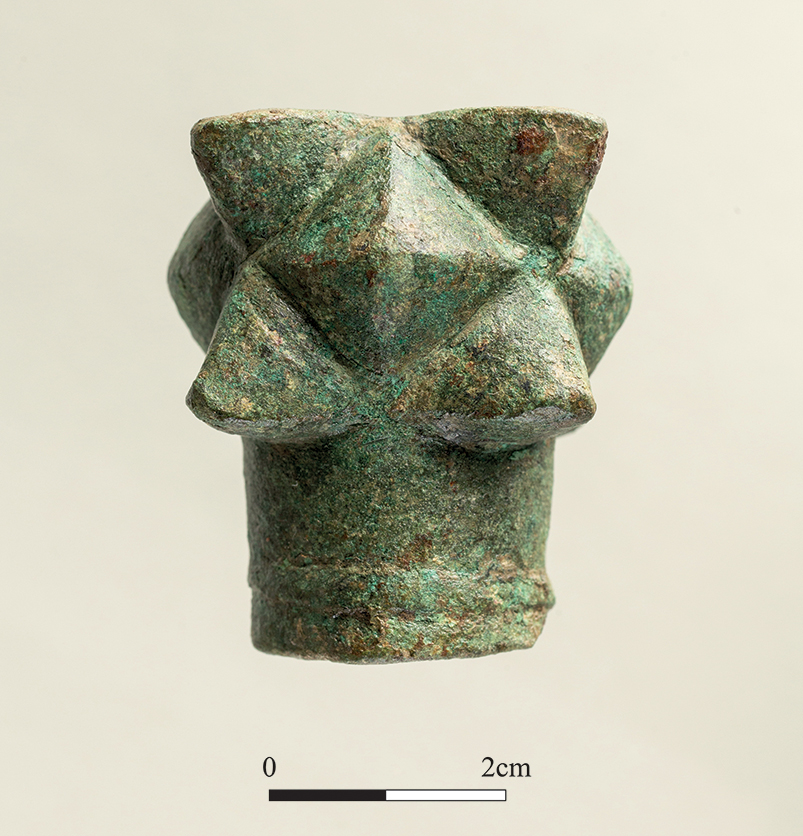We’re proud to have three interesting articles in this year’s proceedings with Streph’s photo of the Cherry Hinton pots, below, making the front cover.

.
‘Occupying the middle ground: further evidence of polyfocal settlement in medieval Cherry Hinton’
by Tom Woolhouse and Frank Meddens
This article details excavations undertaken in 2014, in a little-investigated part of Cherry Hinton on the south-eastern edge of Cambridge, adding to knowledge of its medieval development. The site lies halfway between the two known focal points of the Anglo-Saxon and medieval settlement, at Church End and Mill End.
Unusual ceramic and environmental assemblages from the site, and the find of a medieval copper-alloy mace-head at 58 Fisher’s Lane, 50m west of our site, suggest, intriguingly, that 12th- to 14th-century occupation in this area may have been of relatively high status, or focused on an activity such as beer/ale brewing and consumption, rather than just comprising peripheral activity situated in the low-lying area between Church End and Mill End.
.
‘An Early Iron Age watering hole and Later Roman roadside activity at Thrapston Road, Ellington’
by Katie Anderson
Excavations at this site in 2017, in advance of the construction of commercial buildings, revealed evidence of Early Iron Age, mid to late Roman and post-medieval activity, but the focus of this article is primarily on the later Roman activity (c. AD200–400). This comprised two phases of a trackway extending across the site, as well as a series of enclosures on the northern side of the trackway and associated features including pits and possible structures. The finds assemblages provide evidence of small-scale industry in the form of iron smithing and on-site cereal processing.

An interesting range of small finds includes an assemblage of later 4th century AD Roman coins as well as two styli and two further artefacts associated with weighing and measuring, suggestive of market-based activity, but perhaps of most significance were the two pots pictured above, a large, complete Nene Valley colour-coated jar and a Nene Valley wall-sided lid. These were placed on the base of the ditch, covered by a single homogenous fill, suggesting a foundation’ or ‘closure’ deposit. The use of pottery in ritual deposits within ditches, although rare is not unknown, examples in other parts of Roman Britain occurred throughout the Roman period.
The nature of activity at the site raises questions concerning our current models for site classification in the Roman rural landscape. The site is broadly similar to other contemporary sites in the region, but it does appear to have distinctive morphology in terms of finds assemblages, indicative of several small-scale industries co-existing, with probable market elements occurring with the trackway playing a pivotal role, and thus perhaps deserves its own category (or at least sub-category) of site type in recognition of this.
.
‘Two Prehistoric and Roman Settlements near March’
by Matt Jones
.In this article Matt Jones details two sites near March which revealed evidence for prehistoric and Roman settlements.
At March Road, Wimblington, excavations in 2017-18 identified part of a rural farmstead and associated agricultural landscape occupied from the prehistoric through to the Roman period. Prehistoric evidence consisted of a Bronze Age post-built roundhouse and associated features, an undated ring-ditch and Iron age field boundaries, suggesting that the main settlement lay elsewhere during the Iron Age. In the Roman period activity shifted to the north-western part of the site, comprising a series of rectilinear enclosures, field systems and a trackway as well as three post-built structures, waterholes and finds-rich pits.
At Jobs Lane, March, excavation in 2017 revealed that the site was on the peripheries of a large Roman settlement complex. Apart from an inhumation burial and a single ditch of Iron age date substantial activity on the site began during the 2nd century AD, with the establishment of a series of large agricultural enclosures and associated trackways. Five structures were identified. The later 2nd–3rd century saw an increase in the number of enclosures, an additional post-built structure and a shift towards an industrial emphasis demonstrated by four bread ovens. This trend continued into the later Roman period with the construction of two clay lined water tanks. In the 4th century AD a series of north-south aligned boundaries divided the site into regular ‘strip’ like fields. There were also four large waterholes, two of which had associated superstructures. Part of a building was represented by the remains of wall footings which had survived in one of the earlier ditches.
Together these two sites provide further evidence for the occupation of fenland in the Roman period, and begin to fill in the gap in our knowledge of that period on the fen island of March.


